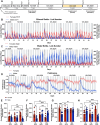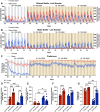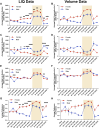A Novel Mouse Home Cage Lickometer System Reveals Sex- and Housing-Based Influences on Alcohol Drinking
- PMID: 39317464
- PMCID: PMC11498228
- DOI: 10.1523/ENEURO.0234-24.2024
A Novel Mouse Home Cage Lickometer System Reveals Sex- and Housing-Based Influences on Alcohol Drinking
Abstract
Alcohol use disorder (AUD) is a significant global health issue. Despite historically higher rates among men, AUD prevalence and negative alcohol-related outcomes in women are rising. Loneliness in humans has been associated with increased alcohol use, and traditional rodent drinking models involve single housing, presenting challenges for studying social enrichment. We developed LIQ PARTI (Lick Instance Quantifier with Poly-Animal RFID Tracking Integration), an open-source tool to examine home cage continuous access two-bottle choice drinking behavior in a group-housed setting, investigating the influence of sex and social isolation on ethanol consumption and bout microstructure in C57Bl/6J mice. LIQ PARTI, based on our previously developed single-housed LIQ HD system, accurately tracks drinking behavior using capacitive-based sensors and RFID technology. Group-housed female mice exhibited higher ethanol preference than males, while males displayed a unique undulating pattern of ethanol preference linked to cage changes, suggesting a potential stress or novelty-related response. Chronic ethanol intake distinctly altered bout microstructure between male and female mice, highlighting sex and social environmental influences on drinking behavior. Social isolation with the LIQ HD system amplified fluid intake and ethanol preference in both sexes, accompanied by sex- and fluid-dependent changes in bout microstructure. However, these effects largely reversed upon resocialization, indicating the plasticity of these behaviors in response to social context. Utilizing a novel group-housed home cage lickometer device, our findings illustrate the critical interplay of sex and housing conditions in voluntary alcohol drinking behaviors in C57Bl/6J mice, facilitating nuanced insights into the potential contributions to AUD etiology.
Keywords: alcohol; microstructure; open-source; sex differences; social drinking; social isolation.
Copyright © 2024 Petersen et al.
Conflict of interest statement
The authors declare no competing financial interests.
Figures







Update of
-
A novel mouse home cage lickometer system reveals sex- and housing-based influences on alcohol drinking.bioRxiv [Preprint]. 2024 May 23:2024.05.22.595186. doi: 10.1101/2024.05.22.595186. bioRxiv. 2024. Update in: eNeuro. 2024 Oct 9;11(10):ENEURO.0234-24.2024. doi: 10.1523/ENEURO.0234-24.2024. PMID: 38826244 Free PMC article. Updated. Preprint.
Similar articles
-
A novel mouse home cage lickometer system reveals sex- and housing-based influences on alcohol drinking.bioRxiv [Preprint]. 2024 May 23:2024.05.22.595186. doi: 10.1101/2024.05.22.595186. bioRxiv. 2024. Update in: eNeuro. 2024 Oct 9;11(10):ENEURO.0234-24.2024. doi: 10.1523/ENEURO.0234-24.2024. PMID: 38826244 Free PMC article. Updated. Preprint.
-
LIQ HD (Lick Instance Quantifier Home Cage Device): An Open-Source Tool for Recording Undisturbed Two-Bottle Drinking Behavior in a Home Cage Environment.eNeuro. 2023 Apr 14;10(4):ENEURO.0506-22.2023. doi: 10.1523/ENEURO.0506-22.2023. Print 2023 Apr. eNeuro. 2023. PMID: 36997312 Free PMC article.
-
Chronic social isolation and chronic variable stress during early development induce later elevated ethanol intake in adult C57BL/6J mice.Alcohol. 2011 Jun;45(4):355-64. doi: 10.1016/j.alcohol.2010.08.017. Epub 2010 Sep 29. Alcohol. 2011. PMID: 20880662 Free PMC article.
-
Sex Differences in Mouse Models of Voluntary Alcohol Drinking and Abstinence-Induced Negative Emotion.Alcohol. 2024 Dec;121:45-57. doi: 10.1016/j.alcohol.2024.07.004. Epub 2024 Jul 23. Alcohol. 2024. PMID: 39053705 Review.
-
Increased voluntary ethanol consumption and changes in hippocampal synaptic plasticity in isolated C57BL/6J mice.Neurochem Res. 2014 Jun;39(6):997-1004. doi: 10.1007/s11064-013-1216-8. Epub 2013 Dec 17. Neurochem Res. 2014. PMID: 24343529 Review.
Cited by
-
Alcohol, flexible behavior, and the prefrontal cortex: Functional changes underlying impaired cognitive flexibility.Neuropharmacology. 2024 Dec 1;260:110114. doi: 10.1016/j.neuropharm.2024.110114. Epub 2024 Aug 10. Neuropharmacology. 2024. PMID: 39134298 Review.
-
BNST GluN2D-containing NMDARs contribute to ethanol intake but not negative affective behaviors in female mice.Alcohol Clin Exp Res (Hoboken). 2024 Oct;48(10):1876-1891. doi: 10.1111/acer.15432. Epub 2024 Aug 23. Alcohol Clin Exp Res (Hoboken). 2024. PMID: 39179522
-
Examining the predictive validity of alcohol-seeking following punishment-imposed abstinence in mice.Alcohol Clin Exp Res (Hoboken). 2025 Jun;49(6):1337-1350. doi: 10.1111/acer.70057. Epub 2025 May 27. Alcohol Clin Exp Res (Hoboken). 2025. PMID: 40420781 Free PMC article.
References
MeSH terms
Substances
Grants and funding
LinkOut - more resources
Full Text Sources
Medical
